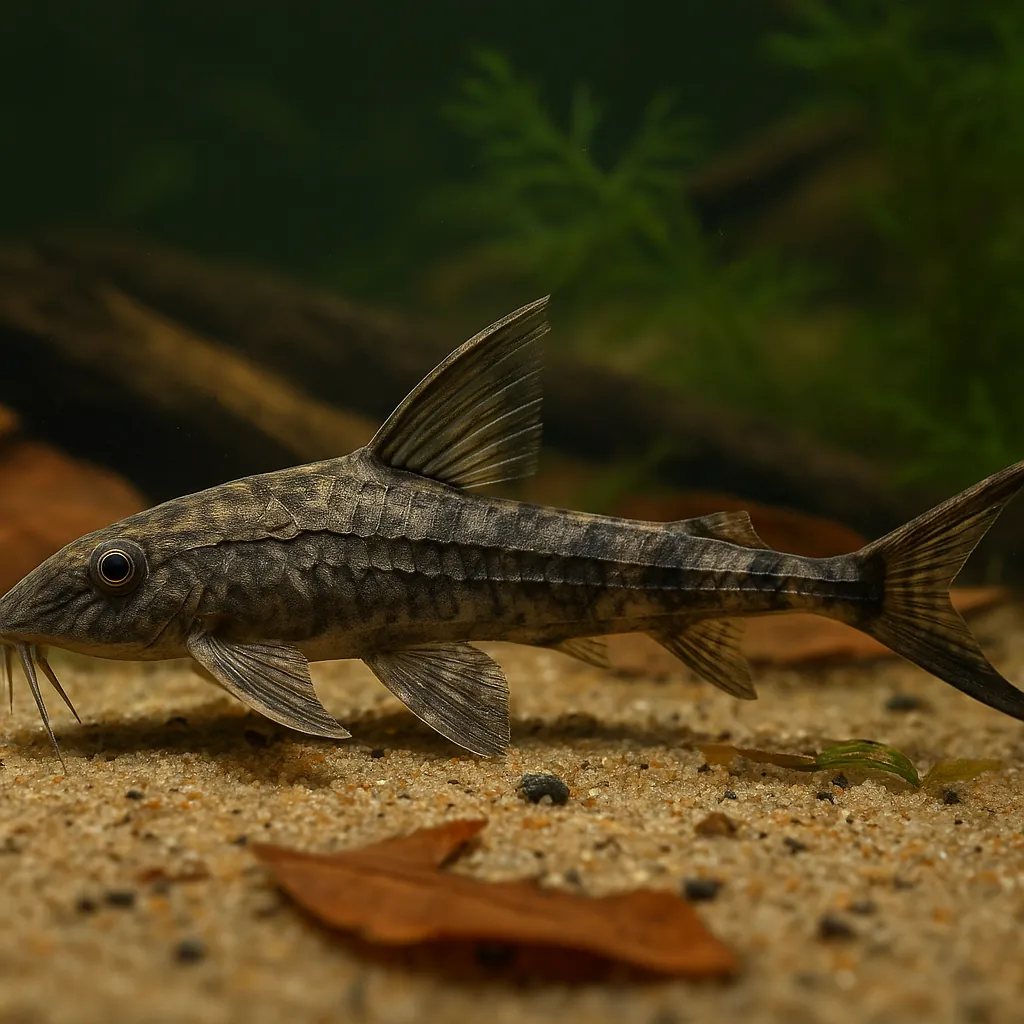
Whiptail catfish
Introduction
The Whiptail catfish, belonging to the Rineloricaria genus, is a distinctive and peaceful addition to freshwater aquariums. Its elongated, slender body and unique appearance make it a favorite among aquarists seeking an unusual yet manageable species. Known for its calm demeanor and compatibility with various tank mates, the Whiptail catfish is well-suited for both beginner and intermediate fishkeepers. While it doesn't have the same reputation for algae-eating as some of its pleco cousins, it still contributes to the tank's ecosystem by grazing on biofilm and detritus.
What makes the Whiptail catfish appealing to aquarists?
Its unique, angular appearance and peaceful nature make it a standout addition to community tanks.
Is the Whiptail catfish suitable for beginners?
Yes, its hardy nature and ease of care make it ideal for novice fishkeepers.
Does the Whiptail catfish help control algae in the tank?
While it grazes on biofilm and detritus, it's not as effective an algae-eater as some other catfish species.
Care and Environment
Caring for the Whiptail catfish involves replicating its natural habitat to ensure its well-being. A minimum tank size of 53 liters (approximately 14 gallons) is suitable for a pair, but a larger tank is recommended for groups. The tank should have a soft, sandy substrate to mimic the riverbeds they inhabit. Adding dried leaves, such as oak or beech, along with driftwood and rocks, provides hiding spots and encourages natural behaviors.
Maintaining stable water parameters is crucial. The ideal temperature range is between 24°C and 28°C (75°F to 82°F), with a pH of 6.0 to 7.5 and water hardness between 5 to 20 dGH. Regular water changes and efficient filtration are essential to keep the environment clean and oxygen-rich. Lighting should be subdued, as bright lights can cause the Whiptail catfish to become reclusive.
In terms of diet, the Whiptail catfish is omnivorous. It feeds on aufwuchs and small aquatic crustaceans in the wild. In the aquarium, it accepts sinking dried foods, vegetable matter (including blanched spinach, courgette, kale, etc.), and live and frozen fare such as bloodworm or daphnia. Feeding should occur once or twice daily, ensuring that food reaches the bottom where they dwell.
What is the minimum tank size for a Whiptail catfish?
A minimum of 53 liters (approximately 14 gallons) is suitable for a pair.
What type of substrate is best for Whiptail catfish?
A soft, sandy substrate is ideal, mimicking their natural riverbed habitats.
How often should I feed my Whiptail catfish?
Feed them once or twice daily with a balanced diet of sinking pellets, vegetables, and occasional live or frozen foods.
Origin and Habitat
The Whiptail catfish is native to South America, specifically found in Peru and Brazil. They inhabit both clear and whitewater environments, often residing among leaf litter over sandy substrates. These habitats are characterized by slow-moving waters rich in submerged vegetation, providing ample hiding spots and feeding grounds. The presence of leaf litter and soft substrates in their natural environment underscores the importance of replicating these conditions in captivity to promote their health and natural behaviors.
Where is the Whiptail catfish naturally found?
It is native to Peru and Brazil in South America.
What type of water bodies do they inhabit?
They are found in both clear and whitewater environments with sandy substrates and abundant leaf litter.
Why is it important to replicate their natural habitat in an aquarium?
Mimicking their natural environment helps promote their health and encourages natural behaviors.
Temperament and Compatibility
The Whiptail catfish is known for its peaceful and non-aggressive nature, making it an excellent addition to community aquariums. It coexists well with other calm species such as small characins, Apistogramma, Corydoras, and other quiet Loricariids. However, it's advisable to avoid housing them with larger or aggressive fish that might outcompete them for food or pose a threat. While they are not territorial, providing ample hiding spots helps them feel secure. They are best kept in small groups to encourage natural social behaviors.
Is the Whiptail catfish aggressive?
No, it is a peaceful species suitable for community tanks.
What are suitable tank mates for Whiptail catfish?
Small characins, Apistogramma, Corydoras, and other peaceful species are ideal companions.
Should Whiptail catfish be kept alone or in groups?
They are best kept in small groups to encourage natural social behaviors.
Interesting Facts
Whiptail catfish have a unique method of reproduction. During breeding, the male selects and cleans a suitable spawning site, often a cave or pipe. After the female lays eggs, the male guards and fans them until they hatch, showcasing a high level of parental care. Additionally, their elongated bodies and camouflage abilities allow them to blend seamlessly with submerged branches and leaf litter, providing protection from predators. Their peaceful nature and compatibility with various species make them a popular choice for community aquariums.
How do Whiptail catfish reproduce?
The male guards and fans the eggs until they hatch, showcasing significant parental care.
How do they avoid predators in the wild?
Their elongated bodies and camouflage abilities help them blend with submerged branches and leaf litter.
Why are they popular in community aquariums?
Their peaceful nature and compatibility with various species make them ideal for community tanks.
Sources
All information in this article has been gathered from the following reputable sources:
Overview
Recommended Tank Size 26.4 Gallons (for groups of 4 or more) |
Minimum Group Size 1 |
Minimum Tank Volume 14 Gallons |
Maximum Adult Length 3.7 inches |
Average Adult Length 3.5 inches |
Shoaling (6+ required) No |
Preferred Water Type Freshwater, soft, slightly acidic to neutral |
Temperature Range (°C) 24-28 |
pH Range 6.0-7.5 |
Water Hardness (dGH) 5-20 |
Typical Lifespan (years) 5 years |